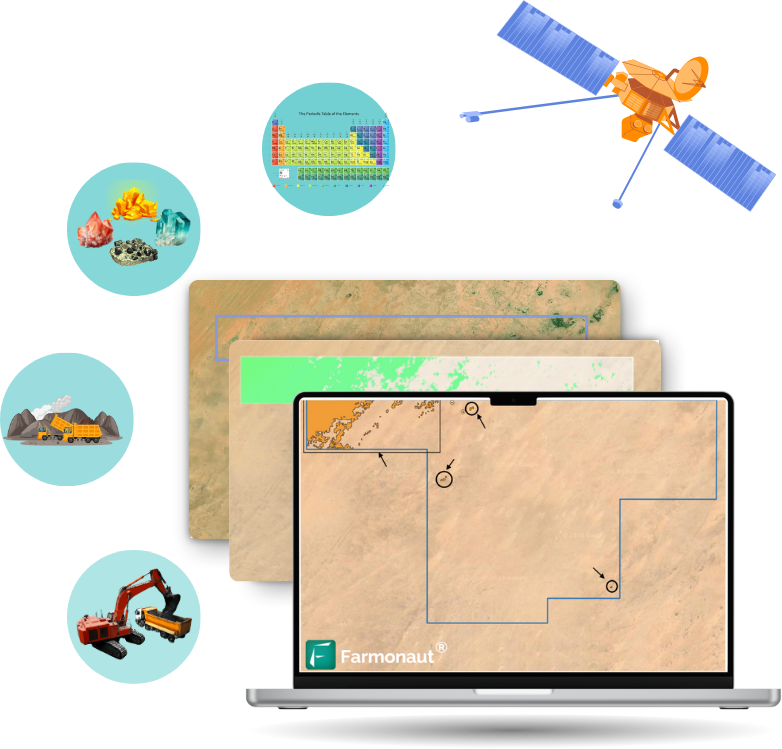Copyright farmonaut

The Ok Tedi Copper Mine: 7 Impacts on Papua New Guinea “The Ok Tedi copper mine produces over 150,000 tons of copper concentrate annually, bolstering Papua New Guinea’s economy.” The Ok Tedi Copper Mine: A Critical Pillar in Papua New Guinea’s Mining Sector Located in the Star Mountains region of the Western Province, Papua New Guinea, the Ok Tedi copper mine remains one of the most significant mining ventures across the Pacific. As of 2026, the mine continues to play a pivotal role in PNG’s mining sector, not only as a key driver of economic development and revenue generation but also as a central figure in shaping environmental and social policies tied to mineral extraction in the region. Throughout decades of operations, the Ok Tedi copper mine has been a source of both prosperity and challenges for PNG. This article will explore the seven most prominent impacts of the Ok Tedi mine—spanning economic contributions, infrastructure development, environmental repercussions, community outcomes, and the road toward sustainable management. Historical Overview: Discovery and Importance of Ok Tedi The Ok Tedi copper mine was discovered amidst the frontier wilderness of Papua New Guinea in the early 1970s. The mine site, primarily known for vast deposits of copper and gold, quickly attracted attention for its economic potential. Following rapid development and feasibility studies under the guidance of international exploration teams, Ok Tedi Mining Limited (OTML), a Papua New Guinean company, began commercial production in 1984. The site quickly became one of the largest producers of copper concentrate in the world. Over the subsequent decades, the Ok Tedi copper mine has: Contributed significantly to PNG’s GDP and export earnings by supplying much-needed foreign exchange revenue Positioned Papua New Guinea as a major exporter on the global mineral map Extended benefits beyond raw value by developing roads, health facilities, and access infrastructure, especially in otherwise remote regions Helped fund governmental programs including investments in education, public services, and local economic initiatives Played a vital role as a major employer both directly and indirectly through supporting industries and services Economic Impact: Mining, Revenue, and National Development The Ok Tedi copper mine remains vital to the broader Papua New Guinea economy as of 2026. The mine supports thousands of jobs, generates valuable export revenue from copper concentrate and gold, and underpins entire local economies in the Western Province and beyond. Economic Benefits: With annual output exceeding 150,000 tons of copper concentrate, the mine supplies a built-in stream of foreign currency, helping balance PNG’s budget and strengthening macroeconomic stability. Budgetary Contributions: Mining revenues reach the national budget through taxes, royalties, and dividends, supporting governmental programs in sectors like education, health, and regional infrastructure. Employment: Direct and indirect jobs have provided thousands of Papua New Guineans with reliable, above-average incomes, promoting skill development and occupational mobility. Export and Trade: The Ok Tedi copper mine’s output remains globally competitive, contributing to Papua New Guinea’s identity as an important mineral exporter within the Pacific region and on the global mineral map. The mine has also encouraged investments in satellite-enabled fleet management—streamlining logistics, reducing costs, and improving road safety across PNG’s mining and transport sectors. Infrastructure Contributions and Regional Connectivity From the Ok Tedi Copper Mine Infrastructure upgrades linked to the Ok Tedi copper mine extend well beyond the mining site. Investments in roads, port facilities, utilities, and public services have not only facilitated mining operations but have actively improved access for local communities, increased trade, and strengthened agriculture in the Western Province. Road Upgrades: The mine has provided crucial funding for building and maintaining roads, opening connectivity between previously isolated villages, markets, and healthcare centers. Port and Export Facilities: By investing in nearby port upgrades, the Ok Tedi copper mine has enabled smoother and more secure mineral export operations. This infrastructure also benefits local traders and farmers by creating new avenues for access to domestic and international markets. Utilities and Public Services: The mine’s presence has led to significant improvements in electricity supply, water access, and healthcare facilities in the Western Province. Satellite and remote monitoring technologies, such as those offered by Farmonaut’s large-scale farm management tools, help optimize the maintenance of these infrastructures by providing oversight of road quality, identifying maintenance needs, and mapping out high-traffic or erosion-prone zones. “Since the 1980s, Ok Tedi mining activities have affected more than 50,000 people along Papua New Guinea’s river systems.” Environmental Challenges of the Ok Tedi Copper Mine While the economic and infrastructure benefits of the Ok Tedi copper mine are substantial, the operation’s environmental legacy is both complex and sobering. From the late 1980s onwards, the mine became internationally known for its ecological damage, with the most critical issue being the disposal of mine tailings and waste rock directly into the Ok Tedi and Fly Rivers. River contamination: The influx of untreated tailings resulted in heavy metal pollution, habitat loss, and siltation of over 1,500 km of river systems in Papua New Guinea’s lowlands. Impact on Agriculture & Fisheries: An estimated 50,000+ local residents along the river corridors experienced decreases in subsistence agriculture yields and fish catch due to degraded water quality and loss of arable land. Biodiversity Loss: Downstream rainforest ecosystems, flood plains, and wetlands have endured profound and in some cases irreversible ecological changes. These extend to native flora/fauna and the unique biodiversity of PNG’s Western Province. In response, Ok Tedi Mining Limited has enacted waste management reforms, intensive environmental monitoring programs, and engaged in remedial efforts aligned with international best practices. Real-time ecological monitoring is also increasingly reliant on advanced satellite data and AI analytics, like Farmonaut’s carbon footprint tracking solutions which can assist industrial sites in quantifying their emissions and shaping transparent sustainability reporting. The 7 Key Impacts of the Ok Tedi Copper Mine on Papua New Guinea The influence of the Ok Tedi copper mine on PNG cannot be overstated. These seven areas encapsulate the most critical medium- and long-term impacts: 1. Economic Growth and Revenue Generation The mine remains PNG’s flagship mineral export operation, underpinning GDP growth and stabilizing national finances. Revenue from copper and gold helps fund development programs and public sector operations. 2. Infrastructure Development and Regional Connectivity Upgrades to roads, ports, and utilities have boosted regional trade, healthcare, and access to education. New infrastructure investments foster ongoing economic activity. 3. Community and Social Impact Thousands of local workers and families benefit from direct/indirect employment and upskilling. But displacement, changing livelihoods, and population influx create significant challenges and require ongoing dialogue between mine operators and communities. 4. Environmental Impact and Degradation Historic practices have caused extensive river pollution, habitat loss, and land degradation. Rehabilitation, waste management reforms, and continuous monitoring remain critical as the mine continues its operation. 5. Agriculture and Food Security Loss of arable land and contamination of water sources have impaired food production and agricultural livelihoods. Mine-funded agricultural extension, satellite land assessment, and digital advisory systems aid restoration and diversification efforts. 6. Health and Public Services Construction of local clinics and hospitals, vaccination and wellness programs have improved public health in mining areas. Conversely, exposure to mining pollution presents ongoing risks requiring robust monitoring and prevention measures. 7. Sustainability, Policy, and Future Outlook PNG’s government and OTML are integrating stricter environmental regulations with sustainable mining policies. The drive to balance resource extraction with social good and environmental stewardship shapes Ok Tedi’s future as a responsible “pillar” of PNG’s mineral sector. Impact Comparison Table: Ok Tedi Copper Mine’s Impacts on Papua New Guinea Social and Community Effects of Ok Tedi Mining The social impact of the Ok Tedi copper mine on local communities and the broader regional population is multifaceted. While the mine provides jobs, skill development, and public services, the disruption of traditional ways of life, population influx, and long-term environmental changes continue to create both opportunities and challenges. Employment and Training: The development of skilled trades, engineering, and logistics positions has elevated income levels and provided long-term career pathways in a region historically characterized by subsistence livelihoods. Community Investment: OTML—with revenues from mine-generated value—funds educational scholarships, vocational training, and community welfare initiatives, including healthcare delivery and clean water projects. Social Challenges: Rapid modernization, shifting demographics, and disputes over compensation for land and environmental damage require inclusive governance and regular dialogue among all stakeholders. Health and Wellbeing: Construction of new clinics, vaccination programs, and clean water initiatives have improved public health outcomes. Conversely, increased prevalence of respiratory and waterborne diseases, linked to mining pollution, highlight the need for sustained environmental and medical monitoring. App-based advisory systems, such as what Farmonaut’s Jeevn AI provides, can support health and community agencies with early-warning alerts, program tracking, and resource allocation decisions. Sustainability, Technology, and the Future of the Ok Tedi Copper Mine Looking toward 2026 and beyond, sustainability is now central to the evolution of the Ok Tedi copper mine’s business model and its role as a “pillar” of PNG’s mineral sector. This means confronting challenges such as: Ore depletion: The mine’s ore body is finite. Resource optimization and advanced exploration technology are required to extend operational life and secure future output. Fluctuating global copper prices: The global market for copper concentrate faces cycles of demand and price volatility, impacting both state and private revenue streams. Environmental restoration and stewardship: Addressing the mine’s environmental legacy necessitates long-term investment in river rehabilitation, habitat restoration, and robust monitoring systems. This is an area increasingly supported by satellite-based analytics (see below). Community transition planning: A comprehensive plan is needed for the eventual wind-down of mining activities, including future use of built infrastructure, skills transfer, and economic diversification in the region. The convergence of mining, agriculture, infrastructure, and digital technology—particularly with the rise of blockchain-based traceability solutions—is revolutionizing transparent reporting in mineral supply chains, supporting ESG (Environmental, Social, Governance) outcomes, and increasing international stakeholder confidence in PNG’s mining industry. Real-time satellite imagery, machine learning, and carbon monitoring (as in Farmonaut’s carbon footprint tracking platform) are empowering mine operators, governments, and environmental agencies to document emissions, optimize rehabilitation activities, and plan for climate resilience across all mining-dominated regions of Papua New Guinea. For real-time integration, see the Farmonaut Satellite Data API — a tool enabling seamless access to satellite monitoring of mining sites, environmental compliance, and resource management. Full developer documentation is available here, empowering your teams to leverage state-of-the-art insights for sustainability. How Satellite Technology Empowers Sustainable Mining at Ok Tedi As mining in Papua New Guinea and worldwide transitions to a model of responsible stewardship, technological innovation is playing a catalytic role. Our team at Farmonaut leverages multispectral satellite imagery and AI-based analytics to provide mining companies, governments, and local communities with: Real-time environmental monitoring: Track deforestation, detect water contamination, and monitor carbon emissions from mining and infrastructure expansion—all essential for ESG and compliance reporting. Resource Use Optimization: Satellite data reveals patterns of land use change, soil erosion, and infrastructure stress. This supports strategic planning and helps reduce the environmental footprint at major mining sites like Ok Tedi. Blockchain-based traceability: From copper and gold extraction at the Ok Tedi copper mine to their entry into international markets, traceability increases consumer trust and enables transparent sustainability disclosures. Learn more about traceability solutions. Carbon accounting: By providing remote, accurate tracking of emissions sources, we help operations align with global sustainability standards. See Farmonaut’s carbon footprint tools. AI-driven operational advisory: Our Jeevn AI system advises on risk management, operations efficiency, and sustainability opportunities, harnessed directly through web, Android, or iOS platforms. Such advanced technologies empower stakeholders across resource-rich areas like PNG’s Western Province to ensure the Ok Tedi copper mine continues to play a pivotal role while protecting community health and preserving the region’s ecological heritage. Want to track your agricultural or mining assets sustainably? Use our web and mobile app for satellite-based, digital resource monitoring in Papua New Guinea and beyond! Frequently Asked Questions: Ok Tedi Copper Mine & Papua New Guinea Mining Conclusion: Shaping Papua New Guinea’s Future with Responsible Mining As we move into 2026 and beyond, the Ok Tedi copper mine remains a cornerstone of Papua New Guinea’s mining sector, a critical pillar in the nation’s economic architecture and a defining influence on the region’s development trajectory. The manifold benefits and challenges of Ok Tedi highlight the importance of sustainable practices, innovative technologies, and stakeholder collaboration. To ensure the long-term prosperity and health of both people and planet, it is essential to: Continue investing in environmental restoration and monitoring Empower local communities through training, infrastructure, and transparent compensation Adopt advanced digital solutions for carbon accounting, waste management, and operational optimization Balance mining progress with ecological stewardship and inclusive growth With responsible stewardship, transparent policy-making, and the integration of the latest satellite-driven insights, the Ok Tedi copper mine can pave the way for a more resilient, equitable, and sustainable future for all of Papua New Guinea.



